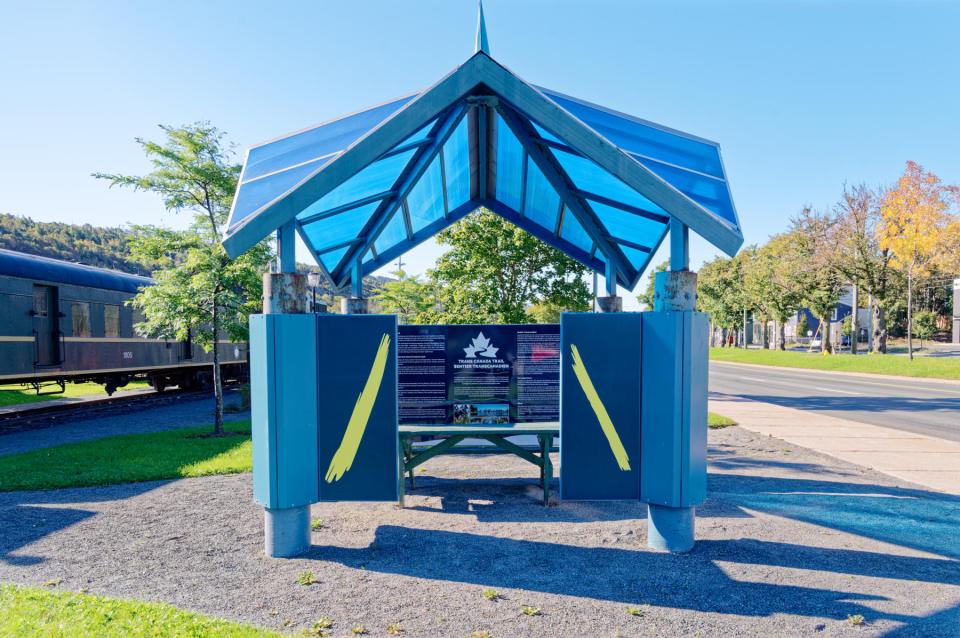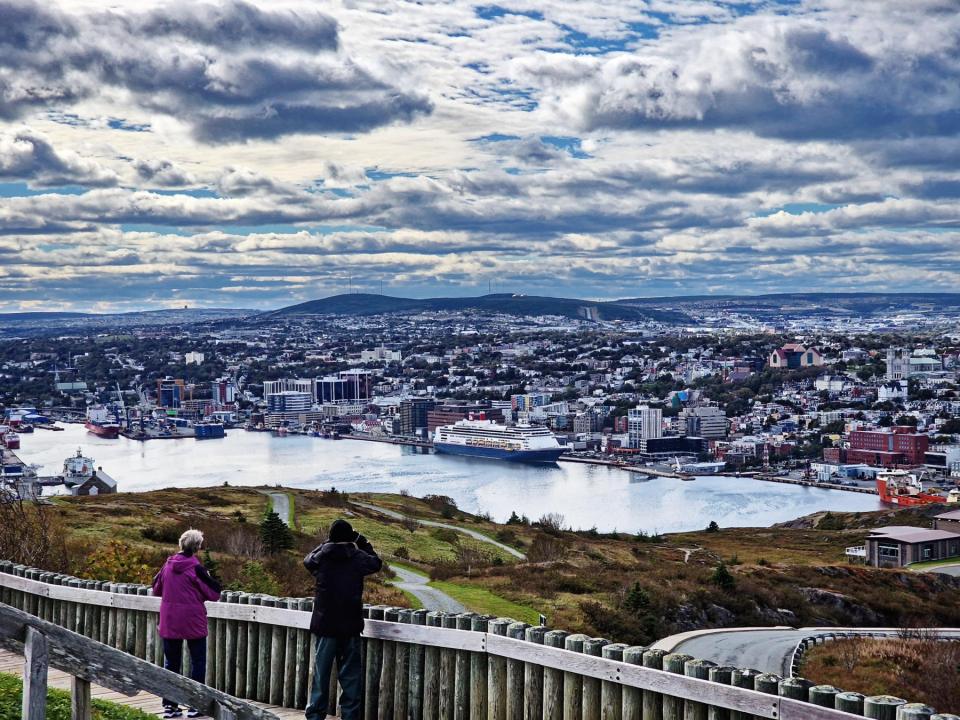Wednesday 5 October 2022 – Sitting in the departure lounge at St. John’s airport, as I typed the headline, I felt a small spasm of sadness, because I’m about to describe the last day of our holiday in Alaska and Canada. Even though it’ll be nice to get home to our own shower, ease of laundry and some control over what we eat at breakfast, we shall be sad to come to the end of a two-month odyssey across North America, because it’s been such a great holiday. Yesterday’s wanderings were a positive contribution to the overall experience.
We started off attempting to remedy an omission from the day before; we’d passed Kilometre (or Mile) Zero of the Trans-Canada Trail without stopping to take account (and a picture) of the formal marker post that Jane had spotted on an internet search just beside the Rail Museum building. Our first stop, therefore, was to take a look at it.
Or, rather, take a look for it.
We could find no sign of the marker board that Jane had seen earlier photos of, even though we bumbled about aimlessly for a few minutes, which is our normal search strategy. We did, however, notice a gazebo set up over some noticeboards.


one of which noted that this was a memorial setup. Reading the information display gives the impression that this is now the formal beginning of the Trans-Canada Trail and the T’Railway we pottered a few steps along the day before,
We then addressed ourselves to the main task of the day – getting back to the top of Signal Hill where driver Basil had shown us our very first glimpse of St. John’s. This time, however, we would be under our own steam.
We passed a rather faded memural (a Steve Walker patented portmanteau neologism – not a typo) to the days when the railway was such a critical part of the history of St. John’s,

and then walked along Duckworth Street, which is one of the main downtown roads in the city. It has its share of the attractive Jelly Bean houses that make the place so individual – even the modern apartment blocks are things of beauty –

and, of course artwork. Above you see part of a long mural which depicts a lot of the traditional ways of life of St. John’s and Newfoundland including

men carrying fish around (cf ladies doing likewise yesterday). We assume this must be salted fish of some description. Duckworth Street is world famous in Newfoundland for being the home of The Duke of Duckworth, a British-style pub.

Tempting as the thought was, we didn’t stop in for a beer, but carried on, past the sort of sights which make St. John’s such an individual place




including an Air Force memorial and a Portuguese memorial (spot the azulejos – blue tiling).


Duckworth Street turns directly into Signal Hill Road, so one could just carry on walking. However, we wanted to follow a trail that took us through The Battery, the cluster of attractive houses we’d walked out to photograph the day before. Where Signal Hill Road carries straight on, Battery Road is a right-hand turn; it also leads past the Battery Cafe


which, I can report, serves damn’ fine coffee.
Battery road goes down a bit and then up quite a lot, giving progressively better views back over the town

as you reach The Battery

and continue up the hill


to the St. John’s Lookout.


At this point, we were at the foot of Gibbet Hill, beside attractively-named Deadman’s Pond. Gibbet Hill is the lump of rock behind the cottages we photographed from the other side of the harbour yesterday…

Apparently only one person was ever hanged on Gibbet Hill, but the name, erm, hung around nonetheless.
Passing Gibbet Hill took us back on to Signal Hill Road and we walked up to the Cabot Tower at the top, past George’s Pond.


Since the hill is pretty much the highest point hereabouts, it’s unsurprising that it gives a great view back over the town


but we were also interested to explore the tower and its history. Construction of the tower itself began in 1898 to commemorate the 400th anniversary of John Cabot’s discovery of Newfoundland, and also Queen Victoria’s Diamond Jubilee. John Cabot, by the way, was actually Giovanni Caboto, an Italian, and there’s a sister tower, of very different architecture, but with the same name and serving the same purpose, in Bristol, UK.
The St. John’s edition of the Tower has a slightly chequered history, in that the town was agin building it in the first place on account of the town having been burned to the ground a few years earlier and the banks going broke an’ that. But there it is, and there it was for its best-known part in the development of the world as we know it – the first successful receipt, on December 12th, 1901, of a radio transmission across the Atlantic Ocean, by Guglielmo Marconi (the origin of the signal, the letter “S” in Morse code, was Poldhu in Cornwall). Its prime use, though, was for flag signalling, it being in a good location for that purpose, visible for miles around in all directions.


We went into and up the tower, and a room at the top has signal flags neatly pigeon-holed all around it

as well as an installation to do with its role in radio telegraphy,

including a picture reconstructing how Marconi set up his receiving configuration. (We read that scientists at the time pooh-poohed his idea that transmission across the Atlantic was possible, but that’s because they didn’t realise that the radio waves would bounce off the ionosphere; I don’t know whether Marconi had realised this or not, actually).

As well as the various old-style cannons visible around the site

and the nearby Queen’s Battery

there’s a more modern one

which we found out about when it went bang. We were actually still quite a way away from the tower at this point but even so it was startlingly loud; heaven alone knows what it was like for the spectators. It is one of the various Noon Day Guns which seem to be popular hereabouts (as well as in Hong Kong).

From the top of the Tower, one can just about see Cape Spear,

the rather uninteresting-looking flat bit of land on the left of the photo above. It is the easternmost point of North America. Just so you know. Also, there’s one of those really helpful signposts telling you how far away you are from civilisation.

So, now you know that Poldhu is a mere 3,468 km away. Given that more civilised northerly and industrial parts of the UK, e.g. Liverpool, are even closer, it’s hardly surprising to learn that British fishing fleets started coming over to Newfoundland in the summers and ended up basically controlled the fishing industry here from about 1600 onwards, having seen off some upstart Portuguese (we were at war with them then).
The other planned component of the day’s walk was to visit a place called Quidi Vidi, recommended by both the mother of the whingeing, squirming brat and the ever-helpful Ian Burley. It’s pronounced Kiddy Viddy, by the way, which sounds to me more like a child’s entertainment. There’s a trail leading there from Signal Hill. It’s a decent trail, albeit a bit rocky and up-and-down in places

but basically very well-maintained in those places where it counts.
We caught sight of Quidi Vidi village fairly soon after starting on the trail

(you can just see the eponymous Quidi Vidi Lake to the left) and before long we were down in the village, at the Wharf end (where the lake debouches into the Atlantic).

It’s ridiculously pretty.

It also has attractions beyond the simply visual.

To be honest, we knew there was a brewery there – Ian B had told us – and so I had a plan which involved a certain amount of quaffing – and the place has a splendid bar and patio for those in need of fluid replacement therapy.


Having partaken of a couple of their offerings

(frankly, Day Boil doesn’t sound like a very pleasant brew, but Jane liked it; and their Iceberg lager is excellent), we walked on through the pretty village, past some rather attractive crocheted rock-cosies (reminiscent of what the natives do to trees in the island of Graciosa in the Azores);


past a couple of historic properties: Mallard Cottage, built in the early 1800s by the Irish-immigrant Mallard family;

and the Inn of Olde (sadly shut);

and what used to be a multi-denominational church.

Our route back to St. John’s took us by the banks of Quidi Vidi Lake on a decent trail, quite a lot of which is a boardwalk

past the St. John’s Rowing Club


and, past the lake, some very large and handsome properties on the outskirts of the town.

We ended up on George Street, which has a simply legendary density of bars and restaurants


(mainly bars, I think, with the occasional “gentleman’s club”), and past a final reminder of how attractive it can be to disguise the mundane with some nice artwork, in this case a map of all the other artwork, which I think is rather a neat idea.

And so, 12½ miles (20km) after we started, we arrived back at our hotel at the end of our day’s walking and our North American holiday. We’ve walked 214 miles (344km – actually not a lot over two months), ascended (and descended!) 4312 metres and enjoyed every minute of it. But we have to go home now – real life, our own washing machine and a defective septic tank await our attention in the UK, but we shall have the memories of all the places we’ve visited for a while and these blog pages for when the memories have dimmed.
For previous holidays, I’ve often penned a summary of our thoughts as a valedictory post. Canada is too vast and diverse, both geographically and culturally, to be able to do it justice, so I shan’t attempt one. A couple of things stand out, though: the helpfulness, politeness and friendliness of the people; the thoughtful approach that Canadians, both citizens and authorities, take to life around them; and the knowledge that we have but scraped the surface of a huge country during a single season – I couldn’t begin to tell you what anywhere here is like during winter, for example. You’ll just have to come and experience it for yourself.
Of course, this is not by any means our last major adventure. We have a real cracker coming up early next year, in February. I hope to be able to regale you with our exploits then and we hope you’d like to rejoin us to hear about them. For now, farewell!

































































































